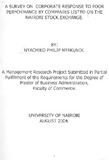| dc.contributor.author | Nyakundi, Nyachieo P | |
| dc.date.accessioned | 2013-05-12T12:23:10Z | |
| dc.date.available | 2013-05-12T12:23:10Z | |
| dc.date.issued | 2004 | |
| dc.identifier.uri | http://erepository.uonbi.ac.ke:8080/xmlui/handle/123456789/22554 | |
| dc.description.abstract | This study sought to establish what course of action companies choose to take in times
of poor performance. There are two broad categories of actions that firms may pursue
in lean times. One is that companies in an effort to improve performance will take
action that is geared towards cutting of costs. Such action includes among others
closure of non profitable branches, layoff of staff and omission of dividend payments.
The other category of action that companies may elect to pursue are those that are
geared towards increased revenue generation. Such actions include increased market
effort by moving to new market areas, forming strategic alliances and employing
managers with skills that will enhance the performance of a firm. In the extreme case
companies may file for protection under the bankruptcy Act in the event that they are
unable to meet their financial obligations as they fall due. Others may altogether fold
up. Yet others may relocate from one geographical position to another. Whatever the
case firms respond one way or the other in lean times.
The Kenyan economy has been on the decline since the early 1990's, because of poor
weather, a dilapidated infrastructure and a decline of prices for Kenyan goods in the
international market. Other factors attributed to this state of affairs include an increase
in the price of oil in the early 1990's caused by the Gulf War, a drop in the Tourism
industry and an Aid embargo from the Development Partners. Almost all companies in
their annual reports state that they have operated under difficult conditions prevailing in
the economy. It is therefore worth finding out what corporate response firms have taken
in the prevailing circumstances.
An investigation of companies listed on the NSE was carried for a ten year period
ending the year 2000. This was done by computing return on assets for each company.
Those companies whose return on assets was below the average return together with
those whose return was above average formed the sample. An analysis was then done
by looking at the annual accounts of each company under study. The study established
that in times of poor performance the most preferred response was that of top
management replacement followed by dividend omission and employee layoffs in that
order. All poor performing companies in the commercial and finance sectors replaced
top management. In the industrial and agricultural sectors 69% and 63% replaced their
top management respectively. Another interesting observation was that in the industrial
and commercial sectors all the poor performing companies omitted dividend payments
while in the finance and agricultural sectors only 47% and 36% omitted dividends
respectively. Less than 50% of all poor performing companies in each market sector laid
off employees. The above three were the major responses that were tested. Another
response noted was asset restructuring. One company sought to improve its revenue by
seeking a strategic alliance. It was noted however that there was no difference between
poor performing companies and well performing companies when it comes to Top
Management replacement. That response was not unique only to poor performing
companies. 5 companies were wound up because of consistently making losses.
The study also established that neither any characteristic considered nor the
market sector has any influence on the course of action poor performing companies will
take | en |
| dc.description.sponsorship | The University of Nairobi | en |
| dc.language.iso | en | en |
| dc.subject | poor Performance by companies listed on the Nairobi stock exchange. | en |
| dc.title | A survey on corporate response to poor performance by companies listed on the Nairobi stock exchange | en |
| dc.type | Thesis | en |
| local.publisher | School of Business | en |

